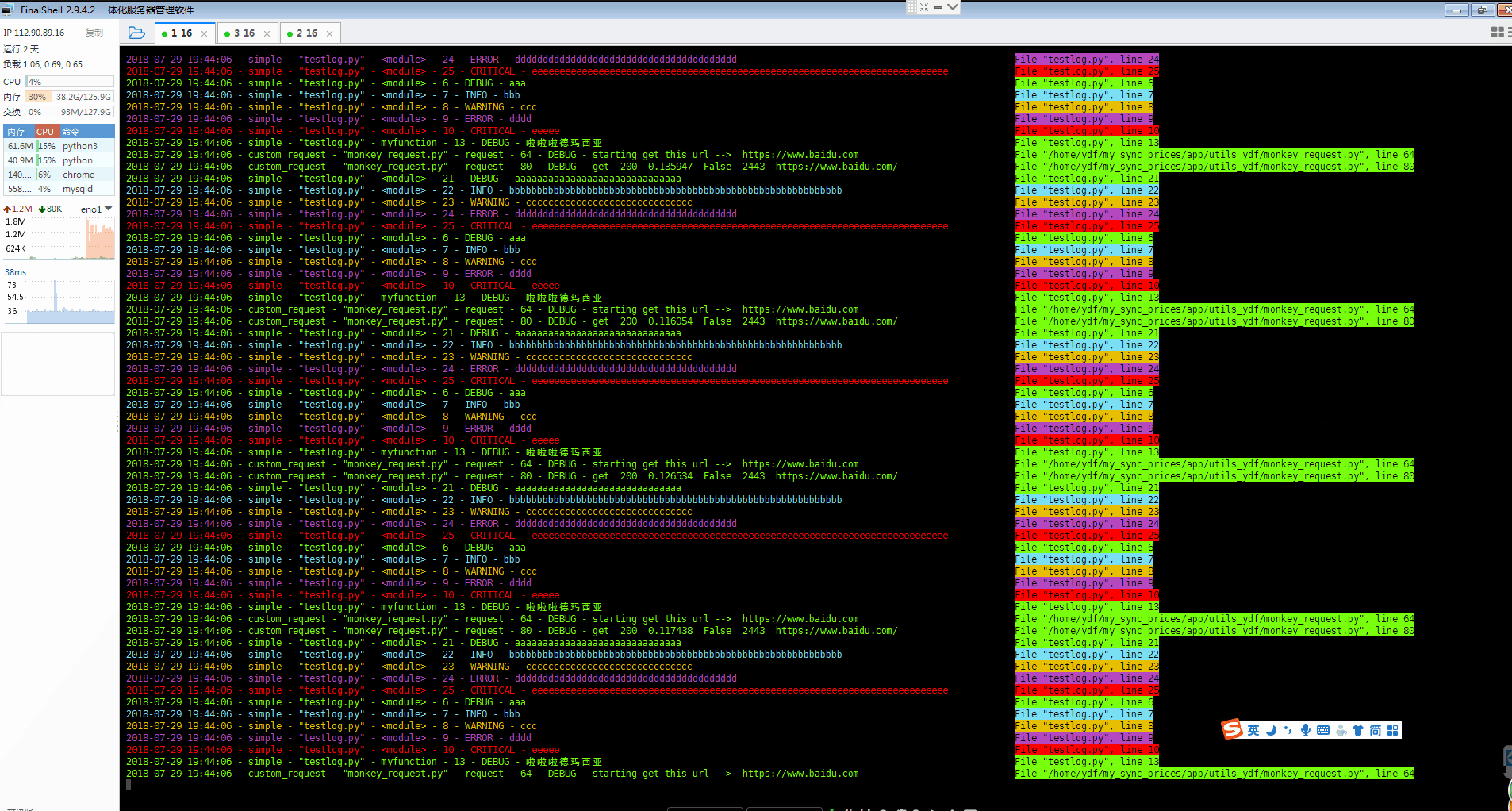使用pyinotify实现加强版的linux tail -f 命令,并且对日志类型的文本进行单独优化着色显示。
tail -f命令不能自动切换切片文件,例如日志是每100M生成一个新文件,tail -f不能自动的切换文件,必须关闭然后重新运行tail -f
此篇使用pyinotify,检测文件更新,并实现tail -f以外,还能自动识别切换切片文件。而且针对日志类型的文件做了单独样式优化。
运行 ./tailf.py + 文件路径。
此文件够自动从普通文本中,对日志就行着色处理,如果不是日志类型的文件,将直接输出,不进行着色处理。

tailf.py文件的实现代码如下:
import os import sys import re import pyinotify DIRMASK = pyinotify.IN_MODIFY \ | pyinotify.IN_ATTRIB \ | pyinotify.IN_MOVE_SELF \ | pyinotify.IN_CREATE class Handler(pyinotify.ProcessEvent): def __init__(self, filename): self._fh = None self._path = filename super(Handler, self).__init__() def my_init(self): try: self._fh = open(self._path, 'r') except IOError as e: sys.stderr.write('open file failed, %s' % e) else: self._fh.seek(0, 2) def process_IN_CREATE(self, event): path = self._path if path in os.path.join(event.path, event.name): if hasattr(self, 'fh'): self._fh.close() try: self._fh = open(self._path, 'r') except IOError as e: sys.stderr.write('open file failed, %s' % e) else: self._fh.seek(0, 2) for r in self._fh.readlines(): # sys.stdout.write(r) process_line(r) def process_IN_MODIFY(self, event): path = self._path if path not in os.path.join(event.path, event.name): return if not self._fh.closed: for r in self._fh.readlines(): # sys.stdout.write(r) process_line(r) def process_IN_MOVE_SELF(self, event): path = self._path if path in os.path.join(event.path, event.name): sys.stderr.write('monitor file move') def process_IN_ATTRIB(self, event): pass class Tailer(object): def __init__(self, filename): super(Tailer, self).__init__() self._path = filename self._notifier = None self._init() def __del__(self): self._notifier.stop() def _init(self): path = self._path index = path.rfind('/') wm = pyinotify.WatchManager() wm.add_watch(path[:index], DIRMASK) handler = Handler(path) self._notifier = pyinotify.Notifier(wm, handler) def run(self): self.read_last_10240_word() while True: self._notifier.process_events() if self._notifier.check_events(): self._notifier.read_events() def read_last_10240_word(self): with open(self._path,'rb') as f: f.seek(-10240,2) for l in f.readlines(): # print(l.decode()) process_line(l.decode()) def process_line(line_str): pass #matcher = re.search(r'\d{4}-\d{2}-\d{2}.*?- (DEBUG|INFO|WARNING|ERROR|CRITICAL) -[\s\S]*?(File ".*?.py", line \d*)', line_str) matcher = re.search(r'^\d{4}-\d{2}-\d{2}.*?(DEBUG|INFO|WARNING|ERROR|CRITICAL)', line_str) if not matcher: print(line_str) else: log_level_str = matcher.group(1) if log_level_str == 'DEBUG': print('\033[0;32m%s\033[0m' % line_str) elif log_level_str == 'INFO': print('\033[0;96m%s\033[0m' % line_str) elif log_level_str == 'WARNING': print('\033[0;33m%s\033[0m' % line_str) elif log_level_str == 'ERROR': print('\033[0;35m%s\033[0m' % line_str) elif log_level_str == 'CRITICAL': print('\033[0;31m%s\033[0m' % line_str) if __name__ == '__main__': if len(sys.argv[1:]) != 1: print('Usage: python tail.py </path/to/filename>') sys.exit(0) path = sys.argv[1] Tailer(path).run()
反对极端面向过程编程思维方式,喜欢面向对象和设计模式的解读,喜欢对比极端面向过程编程和oop编程消耗代码代码行数的区别和原因。致力于使用oop和36种设计模式写出最高可复用的框架级代码和使用最少的代码行数完成任务,致力于使用oop和设计模式来使部分代码减少90%行,使绝大部分py文件最低减少50%-80%行的写法。






【推荐】国内首个AI IDE,深度理解中文开发场景,立即下载体验Trae
【推荐】编程新体验,更懂你的AI,立即体验豆包MarsCode编程助手
【推荐】抖音旗下AI助手豆包,你的智能百科全书,全免费不限次数
【推荐】轻量又高性能的 SSH 工具 IShell:AI 加持,快人一步
· 从 HTTP 原因短语缺失研究 HTTP/2 和 HTTP/3 的设计差异
· AI与.NET技术实操系列:向量存储与相似性搜索在 .NET 中的实现
· 基于Microsoft.Extensions.AI核心库实现RAG应用
· Linux系列:如何用heaptrack跟踪.NET程序的非托管内存泄露
· 开发者必知的日志记录最佳实践
· winform 绘制太阳,地球,月球 运作规律
· AI与.NET技术实操系列(五):向量存储与相似性搜索在 .NET 中的实现
· 超详细:普通电脑也行Windows部署deepseek R1训练数据并当服务器共享给他人
· 上周热点回顾(3.3-3.9)
· AI 智能体引爆开源社区「GitHub 热点速览」